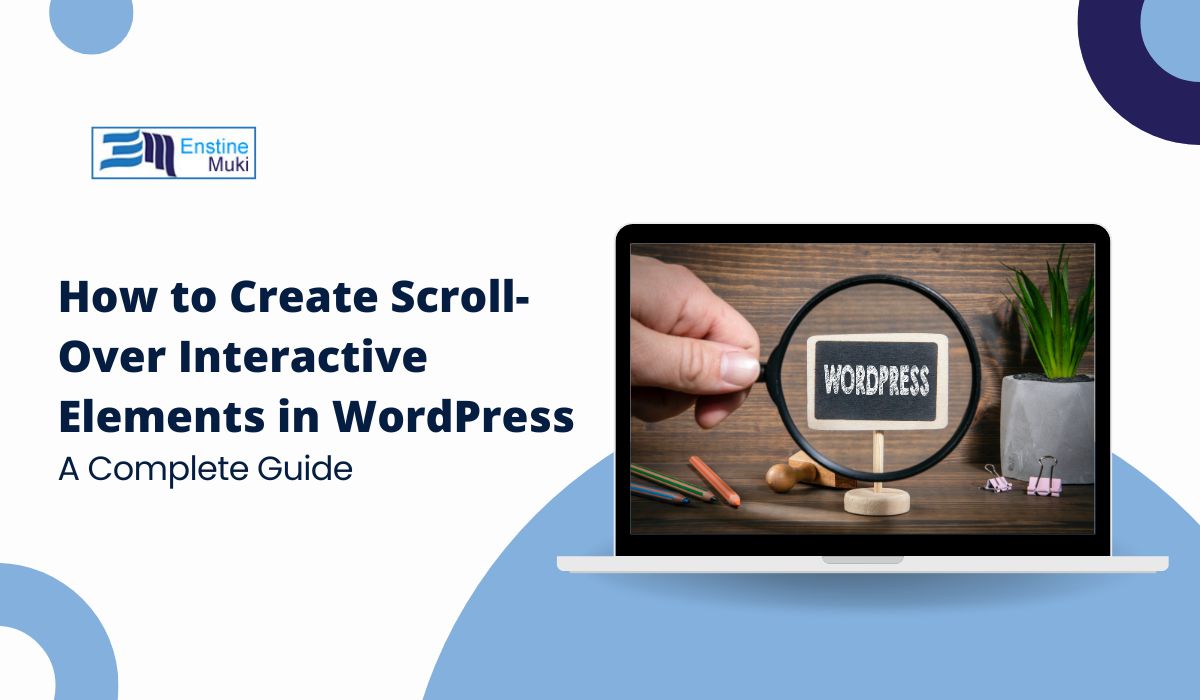Adding scroll-over interactive elements to your WordPress site can make it more engaging and user-friendly. These elements can reveal additional information, highlight key sections, or add visual effects as users scroll. In this guide, we’ll look at how to easily create scroll-over interactions in WordPress, perfect for adding dynamic content to your site.
What Are Scroll-Over Interactive Elements?
Scroll-over interactive elements respond when users hover their mouse over specific areas or scroll through the page. Common examples include images that reveal text on hover, buttons that change color, and sections that animate as users scroll. These effects can guide visitors through content, highlight important areas, and make your site more visually engaging.
Step-by-Step Guide to Adding Scroll-Over Interactive Elements
Here’s a simple, effective way to add scroll-over interactive elements using plugins and a bit of custom CSS in WordPress.
1. Use a Plugin to Enable Interactive Features
For beginners, using a plugin is the easiest way to add interactive scroll-over effects without coding. Here are some popular plugins that make this simple:
- Elementor: This drag-and-drop builder allows you to add hover effects, animations, and interactive elements to any part of your site.
- Hover Effects Pack: Specifically for adding scroll-over hover effects to images, text, and buttons.
- WPBakery Page Builder: Another drag-and-drop builder with various hover and scroll animations.
How to Use Elementor for Scroll Effects:
- Install and activate Elementor from your WordPress dashboard.
- Open the page you want to edit and select Edit with Elementor.
- Add a new section or element (e.g., an image or text box) and click Advanced Settings.
- In Motion Effects, you can add scroll animations like “fade-in,” “slide,” and more.
- Customize each effect to control how it appears when users scroll over it.
Using these plugins simplifies the process, allowing you to create professional animations and effects with minimal effort.
2. Add Scroll-Over Effects with CSS for Custom Designs
If you’re comfortable with a bit of code, adding CSS can give you even more control over scroll-over effects.
Example CSS Code for Scroll-Over Effects:
To add a hover effect on an image that reveals text:
.image-container {
position: relative;
width: 100%;
overflow: hidden;
}.image-container img {
display: block;
transition: transform 0.5s ease;
}.image-container:hover img {
transform: scale(1.1);
}.image-container .hover-text {
position: absolute;
top: 50%;
left: 50%;
transform: translate(-50%, -50%);
color: white;
opacity: 0;
transition: opacity 0.5s ease;
}.image-container:hover .hover-text {
opacity: 1;
}
In this code:
- The
.image-containerclass wraps the image and text. When a user hovers over it, the image scales up slightly, and the text fades in. - Customize colors, transition times, and text styles to match your site’s design.
To add this CSS, go to your WordPress dashboard, navigate to Appearance > Customize > Additional CSS, and paste the code.
3. Create Scroll Animations with CSS and JavaScript
For animations that trigger when users scroll down the page (e.g., fade-in sections), you can add JavaScript along with CSS.
Example JavaScript and CSS for Scroll Animation:
CSS:
.scroll-element {
opacity: 0;
transition: opacity 0.5s ease;
}.scroll-visible {
opacity: 1;
}
JavaScript:
window.addEventListener(‘scroll’, function() {
var elements = document.querySelectorAll(‘.scroll-element’);
elements.forEach(function(element) {
var position = element.getBoundingClientRect();
if(position.top < window.innerHeight && position.bottom >= 0) {
element.classList.add(‘scroll-visible’);
}
});
});
This script checks if a .scroll-element is within the viewport. When it is, it applies the .scroll-visible class, causing the element to fade in as the user scrolls.
To add JavaScript, use the Custom JavaScript plugin or include it in your theme’s header file under Appearance > Theme Editor.
Choosing the Right Effects for Your Site
When creating scroll-over elements, keep these tips in mind:
- Enhance, Don’t Overwhelm: Choose subtle effects that guide users without distracting from content.
- Maintain Speed: Too many animations can slow your site. Test page speed with tools like Google PageSpeed Insights.
- Match Your Brand: Ensure all animations fit your site’s style, using colors, speeds, and effects that suit your brand’s feel.
Conclusion
Adding scroll-over interactive elements to WordPress can greatly improve user engagement. Whether you’re using plugins or custom CSS, scroll-over elements provide an easy way to create a dynamic experience on your site.
Ready to make your site more interactive? Try out these methods and leave a comment if you have any questions or additional tips to share!
